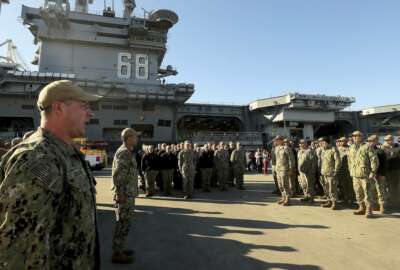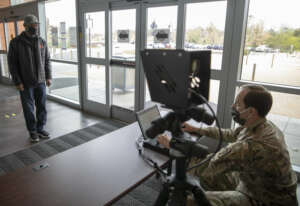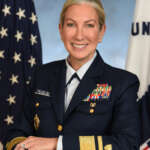
DoD to deliver $3B in accelerated contractor payments over coming weeks
The Pentagon told its contracting officers and contract administrators to boost the amount of money it pays vendors in the form of progress payments as one way to...
The DoD Reporter’s Notebook is a weekly summary of personnel, acquisition, technology and management stories that may have fallen below your radar during the past week, but are nonetheless important. It’s compiled and published each Monday by Federal News Network DoD reporters Jared Serbu and Scott Maucione.
Pentagon says it’s made $1.2B in accelerated contract payments so far
Just over a month ago, the Pentagon told its contracting officers and contract administrators to boost the amount of money it pays vendors in the form of progress payments as one way to increase their cash flow amidst a sagging economy. And the dollars have indeed started flowing.
As of last week, DoD had made $1.2 billion in additional progress payments because of the higher rates — which rose from 80% to 90% of the total contract value for large companies, and from 90% to 95% in the case of small firms. Ellen Lord, the undersecretary of Defense for acquisition and sustainment told reporters she expected the figure to rise to $3 billion in “the next week or two.”
For context, the department’s outlays for contracts are about $25 billion in total during an average month, making the $3 billion in accelerated payments a not-insubstantial sum. Lord said the added progress payments happened across 1,400 separate contracts, mostly because of a mass-modification the Defense Contract Management Agency processed to boost payment rates.
However, one open question — in the case of large contracts — is how quickly bigger firms are passing the advance payments down through their supply chains. Those figures, Lord said, are more difficult to track.
“I believe that the major primes are flowing down. They’ve committed, but I always like to trust yet verify,” she said. “I encourage all of those companies to be as transparent and forthcoming as they can be because we have a responsibility to the taxpayer, as well as to the mid-tiers and the small companies, to make sure actions we take at the prime level do go down all the way through the chain. However, I need to rely on CEOs of major primes to come forth with that data.”
But Lord said the department’s very biggest contractors have all submitted plans to flow those payments down to smaller sub-suppliers. She praised Lockheed Martin in particular, which has committed to prioritizing $450 million of the payments it’s received toward its most distressed subcontractors. — JS
Injecting funds into small business
The Navy and Marine Corps are trying to keep small businesses working during the coronavirus pandemic. The services announced $30 million in rapid-funding opportunities to attract new partners.
“During this national emergency, the Naval Research Enterprise must engage all activities to ensure we accomplish our current workload, make sure vital naval partners survive current economic conditions, and bring in new partners,” said Department of the Navy Small Business Innovative Research and Small Business Technology Transfer Research Director Bob Smith.
The services sent out a broad agency announcement last week, which will be open until the end of May. The Navy are Marine Corps are looking for scalable technologies for maintenance and repair of military assets, digital security analysis, rapid manufacturing and resilient communications.
The $30 million is part of a broader effort to award more than $250 million in funding over the next 90 days to sustain the industrial base. — SM
Army deploys quick solution to screen for fever at building entrances
Even though fever isn’t a perfect indicator of whether someone’s been infected with coronavirus, body temperature is still one of the key tools the military has been using to screen personnel entering its facilities. And the Army’s Rapid Equipping Force believes it’s just made that job a lot easier.

The REF says it was able to test and quickly deploy new thermal imaging sensors that can get a good
read on someone’s body temperature from a distance of 6-8 feet, and within just a few seconds. The devices are especially useful for entry points that handle a lot of volume, like the Pentagon’s visitor entrance, where the equipment has already been deployed on a trial basis.
At that distance, the sensors aren’t as sensitive as a medical thermometer. But Army officials say it’s easy enough to give a “secondary screening” with a forehead thermometer once someone shows elevated temperature levels on the camera-based system.
The Pentagon Force Protection Agency is looking to deploy the new camera-type sensors to other building entrances with heavy foot traffic, like the staff entrance that connects the building to the Washington Metro rail system. — JS
A helping hand
The Army Emergency Relief (AER) is expanding eligibility to National Guard and Army Reserve soldiers who have been activated to assist with the COVID-19 response and are experiencing financial hardship.
Starting last week, any soldier called up under title 10 or title 32, approximately 28,000 to date, can receive benefits. Assistance will be available for basic living conditions and transportation, including: Rent, mortgage, utilities, food, car payments, insurance, gas, and more.
The soldiers will be eligible for assistance during the duration of their activation up to 30 days afterward.
AER provides about $70 million in grants and no-interest loans to soldiers and retired soldiers each year. — SM
Where’s the beef?
Shoppers at some military commissaries need to start limiting their meat purchases. Starting last Friday, the Defense Commissary Agency began limiting how much beef, pork and poultry people can buy in response to shortages in the supply chain. That’s because some meat packing plants have had to close due to COVID-19.
“There may be some shortages of fresh protein products in the coming weeks,” Robert J. Bianchi, DoD special assistant for commissary operations said in an April 30 statement. “Enacting this policy now will help ensure that all of our customers have an opportunity to purchase these products on an equitable basis.”
Shoppers will be limited to two items each of beef, pork, chicken and turkey per visit. Commissaries can also further limit those restrictions or increase the number depending on the supply.
“Our overseas supply chain remains strong,” Bianchi said. “We continue to prioritize quantities for our overseas shipments, so we should be able to support the demand. If we experience any unexpected major hiccups in the pipeline, we will look at expanding shopping limits to other locations.” — SM
Pentagon readies solicitation for new dental care provider
The Defense Department is getting ready to hire a new managed care provider to take care if its troops’ dental needs through 2029.
The Defense Health Agency says it expects to release a final request for proposals by next week for the next round of its TRICARE dental services contract, called Active Duty Dental Program 3. The program mainly covers the costs of civilian dental care when military dentists refer their troops to specialists, and is separate from the premium-based insurance program DHA offers to active duty family members and retirees.
The contract is nowhere near as large as the TRICARE contracts DHA uses for primary medical care, but the value of the current contract – which United Concordia won in 2014 – is nearly $1.2 billion. The next contractor is expected to start delivering services in February of next year. — JS
Keeping innovation flowing
The Defense Department is still trying to keep the pedal to the metal on innovation, even as the coronavirus slows the economy. The Pentagon announced the selection of six collaborative teams as winners of a program to “stimulate competitive research.”
Each team will receive up to $600,000 over three years to pursue science and engineering research in areas relevant to the National Defense Strategy. The competition was available to tenured and tenure-track academics with appointments in 37 states and territories.
“Every state has a vital role to play in America’s research competitiveness, and every state has researchers capable of important contributions to the Department of Defense’s scientific and technological advancement,” said JihFen Lei, the acting director of defense research and engineering for research and technology. “It is crucial that we build a Department of Defense research community that leaves no state behind and takes advantage of each state’s unique research strength.”
Winning teams will work on projects like storing supercapacitors on manned and unmanned surface vessels. — SM
Coast Guard names new top lawyer

The Coast Guard appointed a new judge advocate general and chief legal counsel on Friday. Rear Adm. Melissa Bert is the first woman to hold that position in the service’s 230-year history.
Until her new assignment, Bert had led the Coast Guard’s external affairs operation, overseeing its communications with Congress, the press and other government agencies. Prior to that posting, however, she had an extensive legal background, including as the chief of the Maritime and International Law Office.
Bert, a former national security fellow at Harvard’s Kennedy School, has also taught law students at George Washington University and the University of Miami Law School. — JS
Copyright © 2025 Federal News Network. All rights reserved. This website is not intended for users located within the European Economic Area.
Jared Serbu is deputy editor of Federal News Network and reports on the Defense Department’s contracting, legislative, workforce and IT issues.
Follow @jserbuWFED
Scott Maucione is a defense reporter for Federal News Network and reports on human capital, workforce and the Defense Department at-large.
Follow @smaucioneWFED






